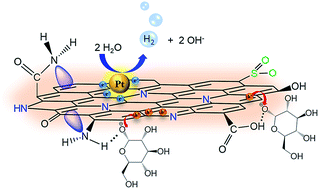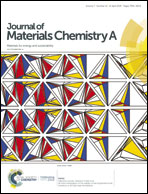Photocatalytic reforming of sugar and glucose into H2 over functionalized graphene dots†
Abstract
Photocatalytic reforming of biomass into H2 combined with its counterpart, photosynthesis, constitutes a sustainable carbon cycle that produces a clean solar fuel. This study reports the use of environmentally benign graphene-based photocatalysts to effectively reform sugar and glucose. We produce a catalyst consisting of sulfur and nitrogen codoped graphene oxide dots (SNGODs) by sequentially annealing graphite-derived graphene oxide with sulfur and ammonia, exfoliating the annealed product into dots, and autoclaving the dots in an ammonia solution. The codoping introduces quaternary nitrogen into the graphene basal plane to patch the vacancy defects and autoclaving creates a conjugation between nitrogen nonbonding states and the graphitic-π orbital by introducing peripheral amide and amino groups. These functionalization steps enlarge the electron resonance domain, narrowing the bandgap and inducing charge delocalization and separation. Here, SNGODs deposited with a Pt cocatalyst effectively catalyzed H2 production from aqueous solutions of sugar and glucose under visible light irradiation for more than 80 h. The apparent quantum yields of reforming of sugar and glucose reach 11% and 7.4%, respectively, under 420 nm monochromatic irradiation. This pioneer study demonstrates the superiority of using carbon-based photocatalysts for biomass reforming and provides a structure-tuning strategy for enhancing the catalytic activity.



 Please wait while we load your content...
Please wait while we load your content...